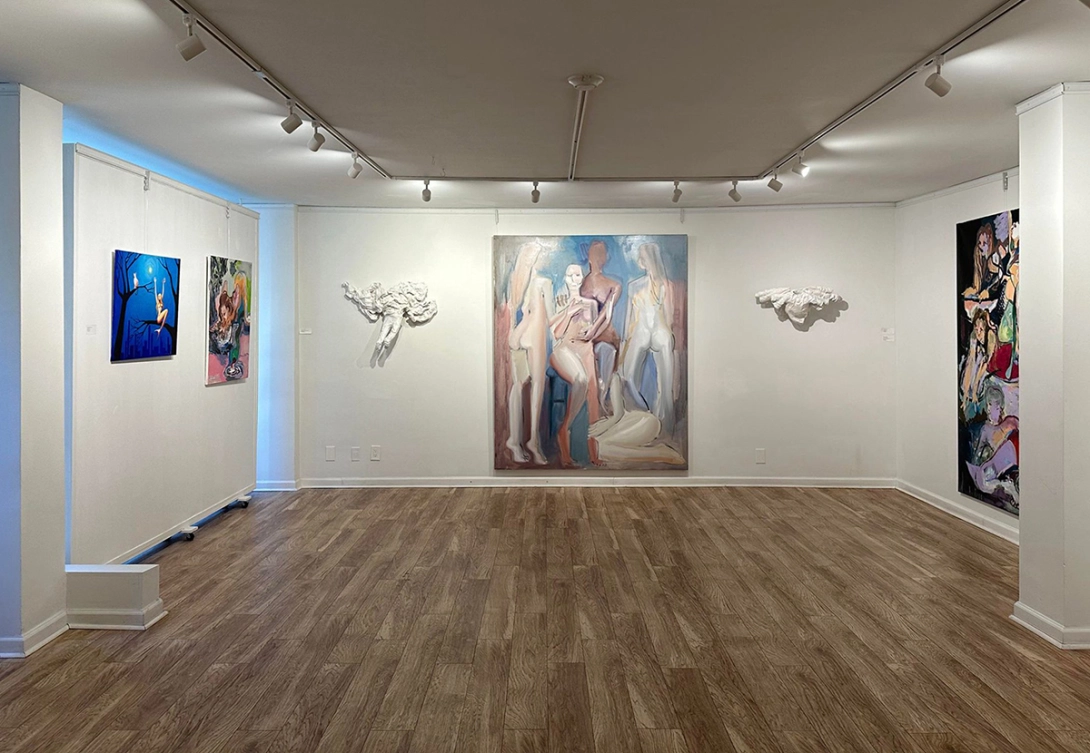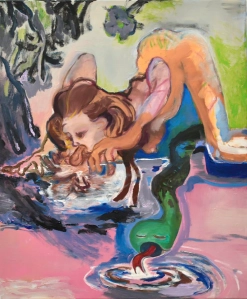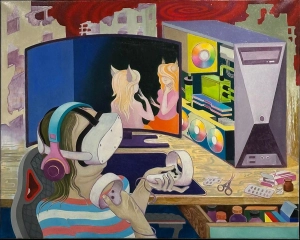Contributor: Michael Wolf
On a cold and rainy early spring day, I met Aida Balamaci and Luisa Tuntuc – Co-curators of “Goddesses, Amazons and Mothers” – at the Romanian Cultural Institute’s Brâncuşi Gallery. Aida is the exhibition’s Co-curator along with Luisa, who serves as Deputy Director/Coordinator of the Visual Arts at Romanian Cultural Institute (R.C.I.) The pair walked me through the exhibition Goddesses, Amazons, and Mothers, which featured colorful and poignant artwork in contrast to the day’s damp weather.
Upon entering the building, guests encounter a totemic sculpture titled Out-Growing II by Romanian artist Ana Maria Morar. Because the artwork is by a Romanian artist, and we are at the R.C.I. – whose very gallery is named after Constantin Brancusi – the square column brings to mind Brancusi’s Endless Column. Brancusi made multiple versions of the sculpture; the largest was commissioned as a war memorial by the National League of Gorj Women to commemorate Romanian soldiers, symbolizing their infinite sacrifice. Morar’s sculpture represents a different sacrifice: the type a mother makes for her children. Morar, an artist and mother, did not want to give up her artistic career after becoming a mother, and found it challenging to find the time to pursue her art. She found herself adjusting and making art from objects found in everyday life. Out-Growing II is a stack of children’s hand-me-down clothes, neatly folded, and covered in plaster. Piled high, the sculpture references the never-ending pile of laundry produced by her children. In the wall-hung sculpture Close to the Body, Morar soaked three child-size children’s shirts in plaster, mounting them in front of the others from small to large. This playful approach echoes how her children were constantly outgrowing their clothes.Morar forges new territory on the topic of motherhood and art-making, creating accessible and thoughtful artwork engaging with this trenchant and ongoing facet that artists who are women often endure.
Above, “Close to the Body” by Ana Maria Morar. Image courtesy Romanian Cultural Institute in Manhattan.
To the left of Morar’s sculptures is a painting titled A Long Time Since We Had a Good Rain by Chiao-Han Chueh: a Taiwanese artist currently based in Germany and represented by Nunu Fine Art Gallery in Lower Manhattan. In the context of a show titled Goddesses, Amazons, and Mothers, a painting of a nude woman and a snake immediately calls to mind the mythical first woman, Eve. Eve is historically depicted tempted by a snake with an apple picked from the Tree of Knowledge, leading to her and Adam’s expulsion from the Garden of Eden. In historical paintings, Eve is represented demurely and passively accepting the apple. In Chueh’s painting, there is no apple, and the female figure is on all fours. Eve is kneeling near a pond, where she rendered with an exaggerated tongue, voraciously and lasciviously gulping water with a snake emerging from between her legs. The demure Eve is vanquished and replaced by a liberated Eve open to her earthly desires.
Above, “A Long Time Since We Had a Good Rain” by Chiao-Han Chueh. Image courtesy Romanian Cultural Institute in Manhattan.
The American artist Angela China began as a street artist and forged her own path to become a prominent figure at the heart of the contemporary art scene, with two paintings on view in the exhibit. Untitled, painted in 2023, takes pride of place at the entrance to the gallery. The work depicts three women, two supporting and holding a lifeless third woman referencing depictions of Christ’s deposition from the cross. This common theme from the Renaissance art period is here treated as a portrait of three women enduring struggle. The two women supporting the third are drawn in a linear fashion while the third figure is fully rendered in thick impasto paint against a vigorously painted black background, creating a powerful and evocative image.Although it is not novel to replace the figure of Christ with a woman – Renee Cox photographed herself nude in place of Christ in her 1996 photograph Yo Mama’s Last Supper – China’s version of the deposition is a more subtle and emotional depiction. Her painting Sisterhood is another take on a canonical painting in Western art history. In it she takes a jab at Picasso’s iconic painting Les Demoiselles d’Avignon. The title Les Demoiselles d’Avignon was given to the painting by Picasso’s friend André Salmon; Picasso, an infamous misogynist, preferred the title Le Bordel d’Avignon or just mon bordel (my brothel). Picasso used sex workers as his models for the painting. He also appropriated images of African masks for three of the women’s faces. China takes Picasso’s painting and flips the narrative, painting the nude figures of five women in the same basic composition and color scheme as Les Demoiselles d’Avignon but eliminating the masks and creating an intimate, tender scene of three women embracing a central figure.
Above, “VR (Mirror Dweller)” by Hortensia Mi Kafchin. Image courtesy Romanian Cultural Institute in Manhattan.
Romanian artist Hortensia Mi Kafchin’s colorful paintings foreground Trans experiences, combining her personal experiences with current technological, environmental, and socio-political issues. The painting VR (Mirror Dweller) presents a character, in front of a computer, visualizing herself in Virtual Reality as an angelic beautiful woman, having on the right side a pink box of hormone pills lying on the desk, with the inner workings of the computer exposed. These referencing the” exposed transformation” she endured. Last year, Mi Kafchin presented a solo show at P.P.O.W. gallery titled Years of Bad Hair. As noted on the P.P.O.W. website, Mi Kafchin’s embraces “…hybridity [as] a central tenet of [her] practice. [This] is innately tied not only to her [gender] transition…but also to her upbringing in a post-Communist and post-Chernobyl Romania in which an influx of Western culture intertwined with deeply rooted Eastern Orthodoxy and Medieval traditions.”
Rooted Beauty by Nana Afya, a Ghanaian American who grew up in the Bronx, is a multimedia installation that offers a sensorial exploration of femininity and spirituality. Afya’s installation is a tree form that “weaves together personal experience, culture, and nature to celebrate African femininity through the lens of hair.” The trunk and the leaves are adorned with braided hair while a video of Afya styling her hair against a soundtrack of her parents talking and her grandmother singing plays in the background. Afya invites viewers to immerse themselves in a world of ritual and symbolism, where the mundane meets the divine. Her use of sound, form, and texture creates a multisensory experience that transcends the physical boundaries, inviting contemplation on the interconnectedness of all things.
Originally from El Salvador, Mariana Cromeyer now lives in New York City, where she creates bold, vibrant paintings inspired by her graphic design experience. Her painting Return to the Body greets visitors entering the cultural institute’s lobby. The vivid yellow, orange, and blue painting is covered with amorphous shapes like whimsical hieroglyphs from a futuristic society. Her experience in graphic design and murals painted in El Salvador inform her paintings on canvas, which can be imagined on a grander scale. A painting of an oversized nude woman resembles the artist who created it, Ekatherina Savtchenko. The figure is depicted climbing the Empire State Building. While painting references King Kong movies this work provides a reversal to the original film as the woman is the giant, holding a diminutive King Kong in her hand. With this gesture of agency, Savtchenko demands that women be in control of their own destinies.
Goddesses, Amazons, and Mothers is a testament to the enduring legacy of strength and resilience that artists who are women seek and demand. Through a diverse array of artistic expressions, this exhibition celebrates the multifaceted nature of womanhood. These works come together to form a captivating tapestry of divine femininity.
The exhibition was conceived by Tuntuc and Aida Balamaci, the show’s Co-curators, and the two bring together an international roster of women artists to create a diverse, eclectic, and thought-provoking exhibition. Balamaci, born in Romania, grew up in Austria, and studied in England, France, and Belgium, and then came to New York. She honed her curatorial skills at the Austrian Cultural Forum and has over ten years of experience working in the United Nations and other cultural institutions. Her curatorial practice focuses on empowering women through the arts.
Goddesses, Amazons, and Mothers runs through April 12 at the BRÂNCUṢI GALLERY, Romanian Cultural Institute, 200 East 38th Street, New York, NY. Gallery Hours are 9 am-5 pm, Monday through Friday.




